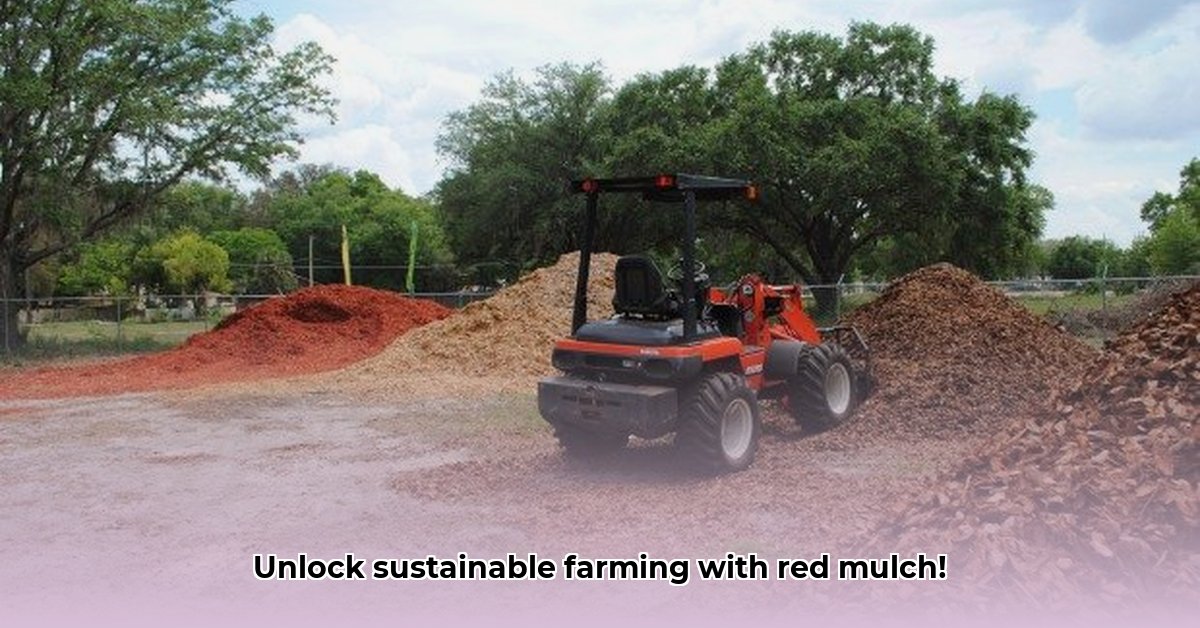
Let's examine red rubber mulch from Tractor Supply. Made from recycled tires, it promises reduced weeding and efficient water retention. However, its sustainability warrants careful consideration. This guide explores both advantages and disadvantages, offering actionable steps for responsible use. For other sustainable options, check out this resource.
The Appeal of Red Rubber Mulch
Red rubber mulch boasts several attractive features. Its water retention capabilities, potentially reducing water usage by 15-20% according to initial studies, are appealing, especially in arid regions. This translates to cost savings and reduced labor. Furthermore, its weed-suppressing properties minimize weeding efforts. The vibrant red color also enhances aesthetic appeal.
Environmental Concerns and Uncertainties
Despite its advantages, the environmental impact of red rubber mulch remains a concern. Microplastic pollution is a major issue. As the mulch degrades, tiny rubber particles contaminate soil and waterways. The long-term effects on soil health and aquatic ecosystems require further investigation. "The potential accumulation of microplastics in the food chain is a serious concern," states Dr. Emily Carter, Environmental Scientist at the University of California, Berkeley.
Additionally, the long-term impact on soil structure and nutrient availability remains uncertain. Preliminary research suggests potential alterations, highlighting the need for comprehensive long-term studies. The manufacturing process itself contributes to its carbon footprint. While offering short-term water savings, its overall sustainability remains unclear.
Actionable Steps for Sustainable Mulch Management
Informed decision-making is crucial. To mitigate potential negative impacts, consider these steps:
For Farmers and Gardeners:
- Conduct Small-Scale Trials: Before widespread application, test a small area. Compare its performance (water use, weed suppression, plant health, and soil indicators) against alternatives like wood chips or straw. Keep detailed notes.
- Implement Long-Term Monitoring: Track soil and plant health across multiple seasons. Observe changes in soil texture, drainage, and plant health. Document your findings diligently.
- Explore Alternative Mulches: Consider composted wood, straw, or other biodegradable options. The optimal choice depends on local conditions and needs.
- Ensure Responsible Disposal: Research local disposal options to prevent environmental contamination upon mulch replacement.
For Researchers:
- Develop Standardized Testing Protocols: Establish universal methods for evaluating the environmental impact of various mulches to ensure reliable data comparisons.
- Conduct Comprehensive Environmental Impact Assessments: Focus studies on microplastic release, soil ecosystem effects, and the mulch's entire lifecycle environmental impact.
- Facilitate Data Sharing and Collaboration: Openly sharing research data accelerates progress and produces a holistic view of the situation.
For Regulatory Bodies:
- Establish Clearer Regulations: Develop and implement regulations for the production, use, and disposal of rubber mulch to minimize environmental risks.
- Ensure Stringent Enforcement: Strong enforcement mechanisms are essential for compliance.
- Promote Sustainable Alternatives: Incentivize the development and use of environmentally friendly mulch alternatives.
For Manufacturers:
- Innovate in Materials and Manufacturing: Invest in research for more sustainable raw materials and manufacturing processes, minimizing the product's environmental footprint.
- Guarantee Transparency and Labeling: Clearly disclose the mulch composition and potential environmental impacts on product labels to inform consumer choices.
- Conduct Life Cycle Assessments (LCAs): Perform thorough LCAs to evaluate the complete environmental impact, from raw material sourcing to disposal.
Conclusion: A Balanced Perspective
Red rubber mulch offers convenience, but potential drawbacks demand careful consideration. Water conservation and weed suppression are beneficial, but microplastic pollution and long-term soil health effects are serious concerns. Further research is needed. Responsible use, along with exploring alternatives, is crucial for sustainable farming and gardening practices. The future of rubber mulch hinges on informed choices and a commitment to environmental stewardship.